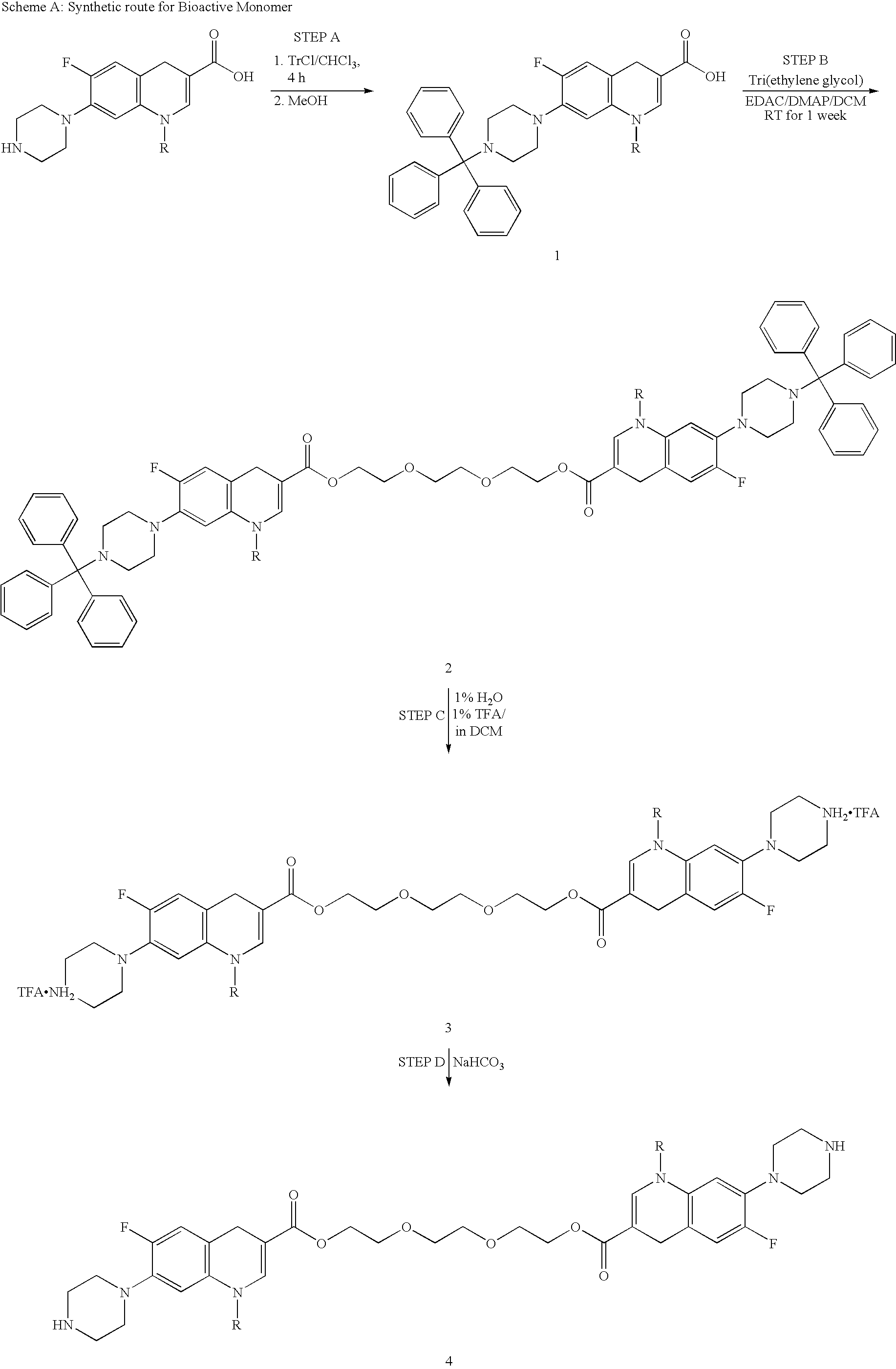Combination therapy for the treatment of bacterial infections
a technology for bacterial infections and conjugation therapy, which is applied in the direction of antibacterial agents, prostheses, catheters, etc., can solve the problems that infections that had been readily treatable by chemotherapy may no longer exist, and achieve the effect of reducing fungal growth and reducing fungal growth
- Summary
- Abstract
- Description
- Claims
- Application Information
AI Technical Summary
Benefits of technology
Problems solved by technology
Method used
Image
Examples
example 1
Determination of the Minimum Inhibitory Concentration (MIC)
[0106]Broth dilution method was used to measure quantitatively the in vitro activity of an antimicrobial agent against a given bacterial isolate. First, a series of tubes / wells were prepared with a broth medium to which various concentrations of the antimicrobial agents were added. The tubes / wells were then inoculated with standardized suspension of the test organism. After overnight incubation at 35±2° C., the tests were examined and the minimum inhibitory concentration (MIC) was determined. The procedures were performed under aseptic conditions.
[0107]Stock culture: Stock cultures were maintained in Mueller Hinton Broth containing 15% Glycerol and stored at −80° C. Stock cultures were sub-cultured on to Mueller Hinton Agar (MHA), and incubated overnight at 37° C.
[0108]Preparation of inoculum: a single isolated colony of the same morphologic type from the MH agar plate culture was selected, inoculated into a sterile tube con...
example 2
General Synthesis of Bioactive Monomers Containing a Membrane Active Biocide or a Fluoroquinolone
[0114]A protocol for the general synthesis of a biological coupling agents (e.g., a membrane active biocide-containing monomeric unit or a fluoroquinolone-containing monomeric unit) is set forth below in steps A-D and Scheme A.
[0115]STEP A:
[0116]To a dry 2 L round bottom flask flushed with nitrogen was added ciprofloxacin hydrochloride (100 g, 301.8 mmol), trityl chloride (185.1 g, 663.9 mmol) and chloroform (1000 mL). To this stirring suspension triethylamine (135 mL, 965.8 mmol) was added dropwise and the resulting mixture was stirred at room temperature for 4 h, during which time a homogeneous yellow solution resulted. The resulting solution was treated with methanol (500 mL) and stirred at 50° C. for 1.5 h. The resulting solution was washed with water (2×2 L). The organic layer was dried over sodium sulphate, filtered, and solvent removed under reduced pressure until precipitate firs...
example 3
Synthesis of Ciprofloxacin Polymer
[0127]To a dry 1 L round bottom flask flushed with nitrogen was added polycaprolactone diol (200 g, 100 mmol). The flask was heated to 70° C. for 2 hours under vacuum. The temperature was decreased to 65° C. before the addition of DMSO (100 mL), dibutyltin dilaureate (3.2 mL, 5.0 mmol) and THDI (32 mL, 155 mmol). The reaction mixture was stirred for 1 h at 65° C. before the addition of 4 (38.84 g, 50 mmol) solution in DMSO (500 mL) and dibutyltin dilaureate (1.8 mL, 3.0 mmol). The reaction was continued to stir for 17 h at 65° C. under inert atmosphere. The reaction was quenched with the addition of methanol (78 mL) and left to stir for an addition 1 hour. The polymer was transferred to a dropping funnel where it was added dropwise to hexane (2 L). Upon discarding the supernatant, the polymer was taken up in isopropanol and again added dropwise to hexane (2 L). The process was repeated with water as the precipitant. The resulting polymer mass is dis...
PUM
| Property | Measurement | Unit |
|---|---|---|
| molecular weights | aaaaa | aaaaa |
| pH | aaaaa | aaaaa |
| volumes | aaaaa | aaaaa |
Abstract
Description
Claims
Application Information
 Login to View More
Login to View More - R&D
- Intellectual Property
- Life Sciences
- Materials
- Tech Scout
- Unparalleled Data Quality
- Higher Quality Content
- 60% Fewer Hallucinations
Browse by: Latest US Patents, China's latest patents, Technical Efficacy Thesaurus, Application Domain, Technology Topic, Popular Technical Reports.
© 2025 PatSnap. All rights reserved.Legal|Privacy policy|Modern Slavery Act Transparency Statement|Sitemap|About US| Contact US: help@patsnap.com

